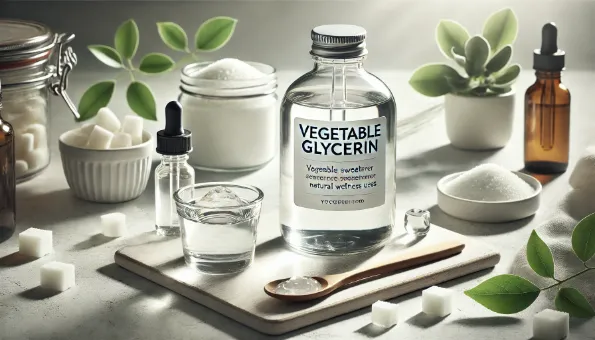Vegetable Glycerin: Plant-Derived Humectant & Low-Glycemic Sweetness
A clear, mildly sweet polyol (≈60–75% sweetness of sugar) that locks in moisture in foods & DIY sauces with a low GI—but still delivers ~4.3 kcal/g and can cause digestive upset in excess.

What Is Vegetable Glycerin?
Vegetable glycerin (glycerol) is a **colorless, syrupy liquid** produced by hydrolyzing or trans-esterifying plant oils (often soybean, palm, coconut, rapeseed) then purifying the glycerol fraction. Technically a **sugar alcohol (polyol)**, it tastes mildly sweet, is hygroscopic (water-attracting) and soluble in water & alcohol.
Nutrition (per 1 Tbsp • 15 mL ≈ 20 g)
| | Amount |
|---|---|
| Calories | ~86 kcal |
| **Carbohydrate (polyol)** | 20 g |
| Sugars | 0 g |
| Fiber | 0 g |
| Protein | 0 g |
| Fat | 0 g |
Energy density ~4.3 kcal/g (slightly > table sugar 4.0). **Glycemic index: very low** (minimal blood glucose rise in most people).
Potential Benefits
- **Low glycemic**: minimal immediate impact on blood sugar compared to sucrose.
- **Humectant**: retains moisture → softer gluten-free or low-sugar baked goods, slows staling.
- **Solvent & carrier** for herbal extracts, natural color/vanilla in homemade syrups.
- Adds **mild sweetness + mouthfeel** allowing partial sucrose reduction.
- Vegan & gluten-free; useful in keto/low-carb recipe formulation.
Drawbacks & Precautions
- **Caloric**: almost as energy dense as sugar; overuse can thwart weight goals.
- Large single doses (≥ 1 g/kg body weight) may cause **bloating, diarrhea or laxative effect** due to osmotic action.
- Can slightly raise **triglycerides** if heavily consumed (excess calories).
- May derive from **palm oil**—environmental concerns if not sustainably sourced.
- Sticky & hygroscopic: too much can produce **gummy texture** in baked goods.
Culinary & Functional Uses
- Replace **10–30% of sugar** in frostings or glazes to retain softness & sheen.
- Add 1–2 tsp per loaf in gluten-free bread to **improve moisture retention**.
- Base for homemade **vanilla, stevia or herbal glycerites** (alcohol-free extracts).
- Prevents crystallization in **low-sugar ice creams or sorbets** (improves scoopability).
- Mix a few drops into royal icing to keep it slightly pliable.
- Blend with cocoa + sweetener for glossy chocolate sauce.
Usage & Substitution Tips
- Sweetness ≈ 0.65 × sucrose: increase amount cautiously; combine with **high-intensity sweeteners** (stevia, monk fruit) for balanced sweetness & bulk.
- Start with **1 tsp (5 mL) per cup (240 mL) liquid** or per 120 g flour in baking tests.
- Excess (>15% formula) can slow drying or cause tacky surfaces.
Storage
Store **tightly sealed**, cool & dark. Shelf life 18–24 months (USP/Food grade). Keep cap clean to avoid microbial contamination; high purity + low water activity resists spoilage.
Sustainability Notes
Choose **glycerin sourced from certified sustainable palm or alternative oils** (coconut, rapeseed) or biodiesel by-product streams (upcycling). Buying from producers with RSPO or equivalent certifications supports reduced deforestation.
Key Takeaways
✔︎ Low glycemic, moisture-retaining sweetener
✔︎ Useful in GF, keto & reduced-sugar recipes
✖︎ Still caloric; excess causes GI upset & tackiness—dose modestly.
- 1. Vegetable Glycerin

